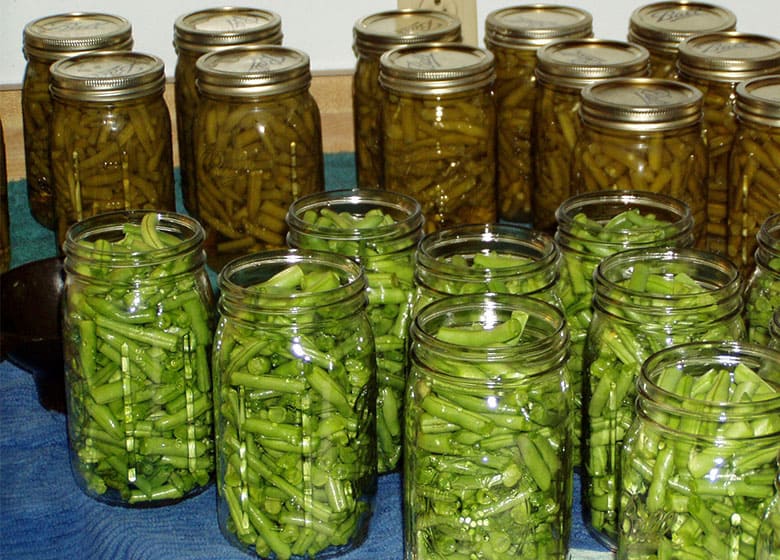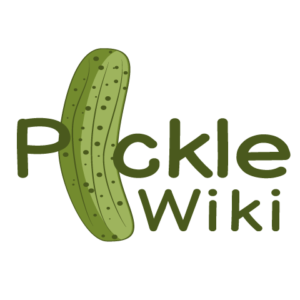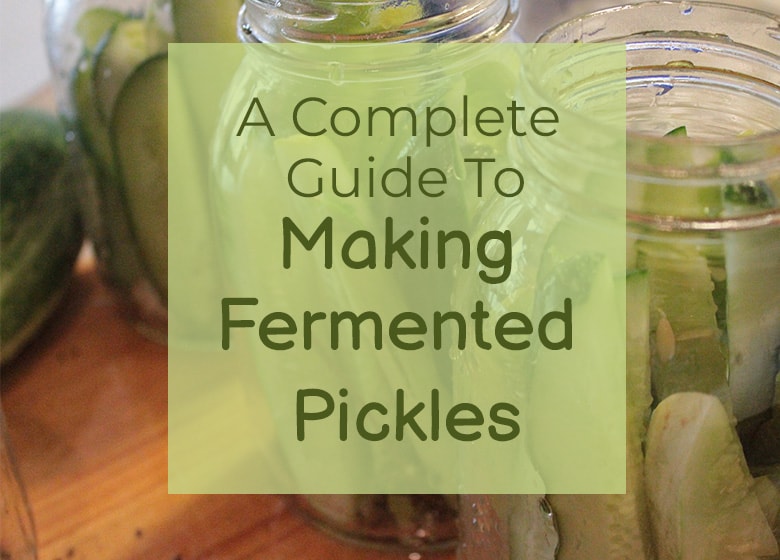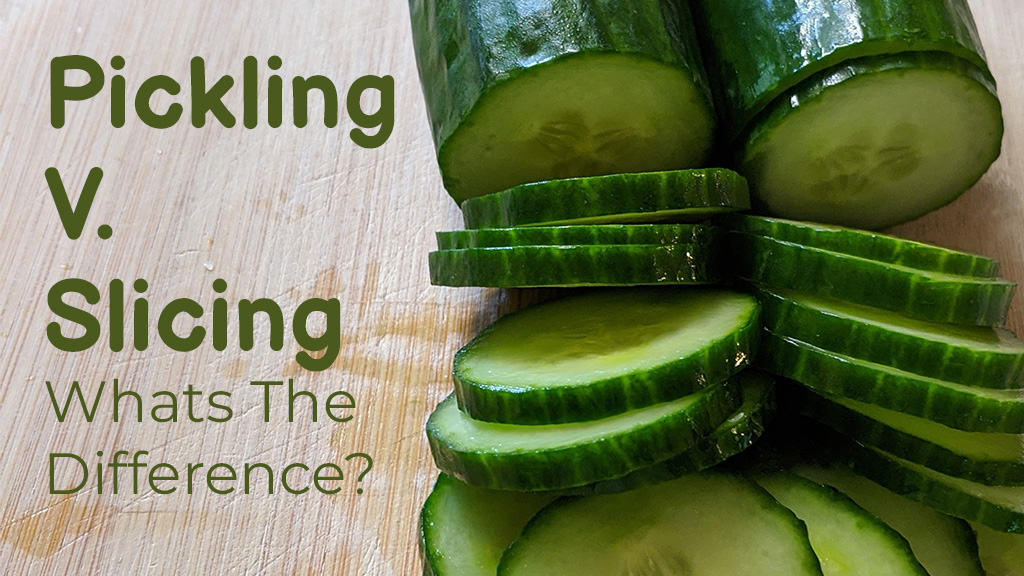You’ve heard of pickles, but have you ever heard of fermented pickles? No? Well, you’re in luck, because this article is all about fermented pickles and how you can make your own at home. Fermented pickles are in the same family as sauerkraut, kimchi, and kombucha, and there’s a lot of interest in them because of the gut health benefits they provide.
Making fermented pickles isn’t a difficult process, but there are a few key elements any aspiring fermenter shouldn’t forget. The steps involved include gathering ingredients, packing the fermenting container, monitoring the process, and then preparing the pickles for long-term storage.
Don’t blame yourself if you’re confused about the differences between pickling and fermenting food. Both of these are pretty old techniques to preserve food, but they do so by different means. Keep reading to find out what fermenting is, its history as a food preservation technique, and how you can make your very own fermented pickles at home.
A Complete Walkthrough to Making Fermented Pickles

Making fermented pickles from the comfort of your own home isn’t a difficult process; in fact, it’s been around in one form or another since at least 6,000 BC. If you’ve never done it, though, it can seem like a daunting proposition. Luckily, this article will help guide you through the process so you can have delicious fermented pickles any time you please.
Generally speaking, fermenting involves several steps and processes. These steps include:
- Gathering ingredients and resources
- Pack fermenting containers with the product to be fermented
- Storing and monitoring fermenting container
- Repack fermented products for long-term storage
Sounds pretty simple, right? While it’s a straightforward process, you should be sure to carefully follow the steps outlined in the guide below. Failure to do so may result in, at best, an inferior outcome, and at worse, fermented pickles that are hazardous to your health.
The Difference Between Pickling and Fermenting
Even though both terms are often used interchangeably, pickling and fermenting are not the same thing. As you’ll see below, pickled foods aren’t necessarily fermented, but in most cases, fermented foods are pickled as well (although inadvertently through the fermentation process, not deliberately as in pickling).
Pickling
Pickling food refers to storing a portion of food in either a brine (salty liquid) or an acidic liquid, like vinegar. The liquid is often heated to destroy any harmful microorganisms. Pickling fruits or vegetables usually involves bringing a mixture of an acid like vinegar to a boil, mixed with sugar, salt, and whatever herbs you feel like using.
The mixture is then poured over the pickled food and allowed to soak. The mixture helps encourage some chemical reactions that change the taste and texture of the food, as well as help preserve it longer. If you’re pickling items with an airtight container, like jarring, they’ll last for years when stored properly.
Fermenting
Fermenting, on the other hand, does not involve an acidic liquid at the beginning. Many fruits and vegetables naturally contain bacteria that, when sealed off from air, destroy other harmful organisms that spoil food. Fermenting uses these beneficial bacteria to help preserve food long term, as well as change their taste and texture.
Salt, yeast, or similar substances help encourage these bacteria to grow, and the result is the natural sugars in the food become an acid, which then preserves the otherwise perishable food. It’s because of this acid that fermented foods are usually also pickled (coincidentally so). It’s kind of the same way all squares are also rectangles, but not all rectangles are squares.
Fermented pickles are sometimes called sour pickles, and they’re the types of pickles you’d expect to find in a New York City deli, on the side of a pastrami on rye or something. The fermenting process naturally leaves a sour taste, and indeed, tasting your pickles for how sour they are is one of the ways you know they’re done fermenting.
Health Benefits of Fermentation
Fermentation naturally results in an abundance of probiotics, which are microorganisms that are essential to good gut health. It seems like probiotics have been a trendy health topic lately, with people trying to incorporate kombucha, kimchi, and sauerkraut into their diets to try and reap the rewards.
Most, if not all, fermented foods result in some level of probiotics. These are, after all, the good bacteria that help ferment the food in the first place. Without getting into too much detail, your gut is a biome that’s home to trillions of bacteria. These bacteria are critical to keeping your digestive system, and as a byproduct, your entire body healthy.
Good gut health has been linked to a variety of other health benefits, including better digestive function, helping to prevent or treat UTIs, treating Crohn’s disease, and even possibly being able to keep a person from getting certain types of cancer.
Gathering Ingredients and Resources

To get started with fermenting your very own pickles, you’ll need to gather all the necessary supplies, ingredients, and resources to do it. No matter what you’re fermenting, many of these items will remain the same. At a minimum, you’ll need:
- Pickling cucumbers
- Jar/container
- Salt
- Water
- Herbs
Pickling Cucumbers
These cucumbers are special varieties specifically intended to be made into pickles. They’re generally 4-5 inches long and about an inch wide, with bumpy skin. You can find them at your local farmer’s market or grocery store.
It’s important to pick the best produce you can when you’re picking for fermenting. Try to avoid picking produce with obvious blemishes or soft spots, as this will negatively affect the final product. Likewise, fresher is better, so try and start fermenting your pickles the day you buy them, so they’re as fresh as possible.
You also want to make sure your produce is ripe for similar reasons. Your cucumbers aren’t going to ripen when they’re fermenting, so making sure they’re ripe beforehand helps ensure they are just the right taste and texture when they’re done. It just helps create a better overall product at the end of the process.
Jar
The best jars are mason jars with sealable lids. That way, you can tighten them as much as your recipe calls for to help in the fermentation process. You also may find your recipe calls for covering your jar with a simple cloth instead of an airtight lid. The seal you want to find is a fermentation seal that allows carbon dioxide out but keeps oxygen from getting in.
The size of your jar also determines how long it’ll take to ferment. Smaller batches in smaller, one-quart jars will ferment more quickly than a five-gallon pail of pickles. Also, smaller jars allow you to experiment more quickly to find the technique and recipe that you like the best, without wasting a bunch of time and resources on larger batches. It helps you learn the process.
Salt
To get the best results, you should use sea salt (unprocessed salt). This ensures you just have salt and no other chemicals that may throw off your results.
Water
Again, you want to find the purest water you can, without chlorination. Filtered water will take out more contaminants so you can avoid having confounding ingredients throw off your fermentation process.
Herbs
Finally, you need the various herbs that will give your fermented pickles a unique and tasty flavor. Just some of the herbs you might consider adding are garlic, dill, fennel, coriander, peppercorns, grape leaf (to keep your pickles hard), and pretty much whatever else you want to use.
The sky’s the limit, and any herbs you add will give your pickles a unique taste. Just make sure to put plenty in, as it’s hard for the flavor to penetrate the cucumbers’ tough outer skin.
Other Items
That’s just about all the things you’ll need to start creating your very own tasty fermented pickles at home. Of course, if you’re serious about fermenting your own food, there are plenty of other items out there that can be helpful. These items include:
- Fermentation Jar Kit: These kits are specially made for beginners and make it all but impossible to mess up your fermentation.
- Stainless Steel Kitchen Tools: Making sure your kitchen implements and tools are clean is essential to the fermentation process. Since you don’t want to introduce any contaminants to the batch, having clean stainless steel bowls and cutlery is a must.
Pack Fermenting Containers
By this point, you’ve gathered all your ingredients and supplies, and you’re ready to go. The next step in the process is where you’re going to pack your fermenting containers, whether those be jars, buckets, or whatever else you’re using.
Clean your jar, kitchen utensils, and the cucumbers you’ll be fermenting first. This ensures that your workspace is as sterile as possible, which keeps you from inadvertently introducing confounding contaminants to the batch. Remember, you want as few extra chemicals or microbes in the batch as possible to avoid interference with the fermentation process.
Once you’ve cleaned your cucumbers, you may consider putting them in an ice bath for up to 20 minutes. This process helps to firm the cucumbers, which in turn may help keep them from getting too soggy and soft when they sit in the brine for days at a time.
Then, you’ll start to make your brine. Typically, you want a brine that’s anywhere from 2.5% to 3.5% salt for optimal results. This helps your pickles go through the fermentation process at the correct rate of speed, which in turn helps them turn out tasting the best.
You need to do some simple math in order to calculate the percentage of salt in your brine. It’s much more accurate if we measure in terms of weight instead of in terms of volume. So, let me give you a real-world example of how to calculate your brine’s salt percentage.
I want to make 5 cups worth of brine with a strength of 3% salt for just a few jars. I want to convert my 5 cups of water into weight instead of volume. A simple google search tells me that 1 cup of water weighs 236.58 grams. My recipe calls for 5 cups of water which means I have a total water weight of 1,182.9 (5×236.58) grams of water. 3% of 1,182.9 (1,182.9 x .03) is equal to 35.5 grams of salt.
We just simple add 35.5 grams of salt to our 5 cups of water and now we have a salt brine with 3% strength.
If you wanted a brine of 3.5% strength you would simple multiply your total water weight by 0.35.
Once your brine is made, you’ll start placing your cucumbers and whole herbs in the jar or container you’ll be using. Don’t pack it too tightly, but also don’t be stingy, especially when it comes to the herbs. Plenty of herbs and spices ensure your pickles will be tangy and flavorful. You also don’t want any cucumbers poking over the lid.
You have to make sure the brine completely covers the pickles, which means you may need to use a weight to hold your cucumbers down. A sterilized rock is a fine choice, or you can find a special fermentation weight to help hold the cucumbers down. Regardless of what you choose, if you have parts of cucumbers above the brine, they’ll mold during the fermentation process.
After you’ve poured in your brine, place the jar lid on loosely. This allows carbon dioxide to escape from the jar but keeps oxygen from getting in. After all, the bacteria that activate during the fermentation process can only do so properly when in an oxygen-deprived environment.
Storing and Monitoring Your Fermented Pickles

After you’ve packed your jars full of soon-to-be delicious pickles, it’s time to properly store the jars. For the fermentation process, this means a cool, dark spot like a kitchen cupboard or a basement. Cooler temperatures slow down the fermentation process, while heat tends to speed it up. Fermenting at higher temperatures also tends to make mushier pickles.
When you first put your fermenting pickles into their fermenting spot, you’ll want to leave them undisturbed for about three days. After three days, you should check to see if you see any bubbling in the jar. Bubbling is a good sign and means your pickles are fermenting. You also want to check the top of the brine for any sort of film or mold growth.
Generally, a film at the top of the pickles is benign and won’t threaten your health. You can just scoop it off and discard it, as it’s a natural byproduct of the fermentation process. If you see mold, however, you probably should discard your pickles and start over. Mold can have harmful substances for humans, even if you scrape it off.
After about three days, you should keep checking your pickles and “burping” them at least daily. Burping simply refers to loosening the lid to allow the carbon dioxide to escape the container, then replacing it. It’s a pretty simple process, but one that’s critical to having pickles that turn out great.
Once you start seeing bubbling, you can feel free to taste your fermented pickles. At this point, they’re done fermenting when you say they’re done fermenting, and if you like the taste and texture, you can put them in the refrigerator. This will slow the fermentation process even further, though you may want to let them ferment slowly for a few more days.
The fermentation process usually takes about a week under optimal conditions. Depending on the temperature you stored them at and the size of the batch, you may experience it being shorter or longer. Don’t worry, as long as you see bubbles, your pickles will be fine to eat.
Repack for Long Term Storage
Finally, you get to enjoy the fruits of your labor and enjoy your fermented pickles for a long time. But how do you go about storing them for the long-term? If you keep them in a jar in your fridge, fermented pickles will last about a month. In some circumstances, you can keep them for up to a year without worrying about them going bad.
Once you’ve finished the fermentation process, you can move your pickles to a new container with new brine to keep them long term. Again, you’ll probably want to keep these pickles refrigerated. If you go through the process of canning them, however, you may be able to keep them for anywhere from one to five years in your pantry.
Jarring, or canning, is the process of sealing food in an airtight container and pushing out the air that’s inside to get rid of microorganisms that are involved in food spoilage. Although the process of canning is beyond the scope of this article, here’s a great guide that will walk you through exactly what you need to do to can your fermented pickles to enjoy for a long time.
Even if you don’t go through the whole process of canning your pickles, storing them in an airtight container in the fridge may leave them edible for up to a year. That’s pretty impressive. Of course, keep an eye on your pickles, and if you see any sign of decay or mold growth, you may not be able to eat them.
Other Things You Can Ferment
You’re not simply limited to fermenting pickles, though. There are plenty of fruits and vegetables that can be fermented, whether because you enjoy the taste or because you want to start preparing and storing your delicious food at home. No matter the reason, here’s just a few of the many different perishable food items you can ferment from the comfort of your own home:
- Pepperoncinis
- Cauliflower
- Peppers
- Garlic
- Eggplant
- Carrots
- Cabbage (hello sauerkraut!)
- Peaches
- Plums
- Apricots
- Mangoes
- Pineapple
You’re limited by just your imagination when it comes to what you can ferment. You can even ferment fish if that’s something you’re into. People have also been fermenting meat for thousands of years as well by salting it for storage, which is yet another thing you can do with your new-found fermenting knowledge.
Best Jars to Use for Fermenting
Below, you’ll find some example jars to use for your fermenting, as well as the lids. The lids are arguably more important than the jars, as a good one will help seal out oxygen while also allowing carbon dioxide to escape. Here’s a list of five good jars and fermentation jar kits available on Amazon:
Jillmo Fermenting Jar
This Jillmo Fermenting Jar kit includes pretty much everything you need to start fermenting pickles as soon as possible. They’re two-quart jars with a specially designed cap and water chamber that allows gas to slowly escape from the jar. They also come with fermentation weights to make sure your cucumbers stay fully submerged in the brine.
Fastrack One Gallon Fermentation Jar
This is another example of a fermentation jar that has a special reserve chamber at the top designed to allow carbon dioxide to slowly escape the jar. These non-descript pack of two jars provides an airtight seal, and they’re pretty inexpensive to purchase as well.
Soligt Fermentation Kit
This cool little kit contains pretty much everything you’ll need to start fermenting your very own pickles at home. It has jars with special fermentation lids, fermentation weights to keep your vegetables fully submerged, and even a pump to get rid of mold. They also have one-way valves incorporated into the lids to release gas, so you don’t have to burp the jars daily.
K Kernowo Fermentation Lids
These lids, which come in a four-pack to fit standard wide-mouth mason jars, provide an airtight seal and a slow-leak reservoir at the top of the lid designed to allow carbon dioxide to escape while fermenting. The jars are not included with this item, but they’re supposed to fit any standard wide-mouth mason jar.
Kenley Fermentation Crock
This large-size Kenley Fermentation Crock is capable of holding up to 8 lbs. of fruits or vegetables, making it a great option for someone who’s trying to do a large batch of fermentation. It, too, has a special lid that allows gas to escape the fermentation chamber while at the same time keeping air out, and it has two stylish weight stones included that fit it perfectly.
Tips for Fermenting Food Safely
Whenever you’re handling food, you want to make sure you’re doing it safely, so you don’t get food poisoning or something worse. As you’ve already seen, fermenting is pretty fool-proof, but there’s still no harm in knowing some basic safety considerations before you get started.
- Don’t reuse brine. Once you use your brine once, discard it and start a new brine. Reusing brine can lead to harmful bacteria gaining a foothold in your fermenting pickles.
- Temperature control is important. Too much heat can lead to harmful bacteria growth, as well. The optimal temperature for fermentation is between 70 and 75 degrees Fahrenheit.
- Use only food-grade containers, instruments, and bags. Don’t use trash bags for anything throughout the process, as it’s not intended to handle food that will be eaten.
The History of Fermentation
If you’re not interested in how fermentation came to be and how it’s been used for millennia to preserve a wide variety of food. The history of fermentation as a food preservation technique is an interesting story. It’s incredible how humans came up with fermentation without knowing about bacteria or microorganisms.
Fermenting beverages has been around for even longer than fermenting food, since wine and similar alcoholic beverages have existed since around 7,000 BC in Egypt, even before than the earliest evidence of fermented food. At first, fermenting was probably a natural occurrence that people didn’t necessarily plan for, but they learned how to harness it to keep food lasting longer.
Many ancient cultures have had different types of fermented foods; in fact, many cultures from around the world gave rise to one common, well-known fermented type of food or another. Some of the best-known examples are listed in the table below.
| Location | Food | Estimated Time of Invention |
| Central Asia | Yogurt | 6,000 BC |
| India | Pickles | 2,030 BC |
| Manchuria | Kombucha | 220 BC |
| Korean Peninsula | Kimchi | 1,000 BC |
| China | Sauerkraut | 1 AD |
This is just a small idea of the widespread application of fermentation among humans for thousands of years. At some point, probably after an accident where yeast or another microbe got into food, people started to realize that introducing certain things to their food and letting it sit for a few days would make it last longer and, possibly, taste better.
While humans didn’t know about the existence of microbes until very recently, they were able to figure out that putting various naturally occurring substances, like yeast, on foods would help the food last longer and, in many cases, taste better. Pickling and fermenting were around before fridges were ever invented, which allowed humans to store food for the winter and thus survive.
You have to imagine this was a trial-and-error discovery that took decades or centuries to figure out, as people had no idea what microbes even were until very recently. The importance of the discovery of how to ferment food and store it long term can’t be overstated. Without it, people would have lost a powerful tool to help them store food through the non-growing season.
Closing Thoughts
It’s pretty simple to ferment your pickles at home. You only need a few ingredients, a little bit of time, and the willingness to try something new and possibly fail the first few times. Luckily, fermentation is not complicated and has been around for thousands of years, so the odds you screw it up are pretty small. They’re even smaller now that you’ve read this entire guide!
Hopefully, you’re motivated to go out and try fermenting your pickles. Instead of buying generic pickles at the store, fermenting your own allows you to experiment with your unique taste and flavors by adding different herbs, vegetables, and tastes. The most important thing, though, is to learn and fun!


